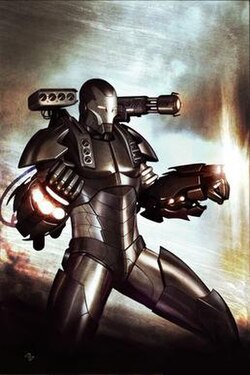20th century
James Rhodes was created by writer David Michelinie with artists John Byrne and Bob Layton. Rhodes first appeared in a single panel of Iron Man #118 (1979), introduced as a friend of Tony Stark, and he saw a recurring role as Stark's personal helicopter pilot. Many comic books and other works in popular culture had begun introducing duos of one white character and one black character. Such a development had not occurred in Iron Man until Rhodes's introduction. One African American character, Eddie March, was introduced as Iron Man's successor in Iron Man #21 (1970), but this character was severely injured and written out of the series before being elevated as Iron Man's partner. Shortly after his first appearance, Rhodes assisted Iron Man in defeating Justin Hammer throughout issues published in 1979. He was established as a more prominent supporting character in Iron Man #144 (1981), which described his connection to Tony Stark and how they met during the Vietnam War. This depiction of Rhodes made him a central character in Iron Man's history and origin, elevating his importance beyond what had been written for Marvel's black characters to that point. [8]
When Denny O'Neil was the writer for Iron Man comics, he chose to write Stark out of the role entirely in favor of Rhodes. Rhodes was first portrayed using Iron Man armor in Iron Man #169 (1983), when he had to fight a villain in the stead of a drunk and defeated Tony Stark. A black superhero replacing a white one was almost unprecedented at the time, with DC Comics having only recently attempted a similar change with its character John Stewart, who was created by O'Neil. From this change, O'Neil created a story arc in which Stark relapsed into alcoholism and Rhodes reluctantly took up the armor and the title of Iron Man. The change saw mixed reactions from readers, as Rhodes's tenure as Iron Man emphasized his lack of experience or expertise regarding the Iron Man armor. For the duration of the story arc, the Iron Man series focused primarily on Rhodes, with Stark's recovery being relegated to a subplot. It also included the Secret Wars crossover event, which featured Rhodes as Iron Man rather than Stark. Stark resumed the role of Iron Man in Iron Man #200 (1985).
During Iron Man's 1988 Armor Wars story arc, Rhodes accompanies Iron Man in his mission to fight those who had acquired the Iron Man armor technology. Rhodes again served as a replacement for Stark beginning in Iron Man #284 (1992), while Stark was in suspended animation. He began using the War Machine armor at this time, continuing as Iron Man until Stark returned the following year in issue #289. Keeping the War Machine armor, Rhodes was established as a new superhero, War Machine. He subsequently appeared in Avengers West Coast beginning in issue #94 (1993), but the series ended shortly afterward.Iron Man writer Len Kaminski did not intend to give Rhodes the War Machine armor permanently, but editor Nel Yomtov insisted after it was well received.
War Machine was one of several characters to serve as grittier and more violent anti-hero versions of established characters during the 1990s. The character received his own series with the release of War Machine #1 (1994), written by Kaminski and Scott Benson and penciled by Gabriel Gecko. This series featured Deathlok and Cable as supporting characters, and it ran for twenty-five issues across two years.War Machine was introduced with a story relating to Africa and the continent's politics, reflecting Western interest in the subject following widespread reporting of the Somali, Rwandan, and Liberian civil wars. By issue #15 (1995), the focus shifted to speculative fiction involving aliens and time travel. Rhodes was given an alien symbiote armor during this series to differentiate him from Iron Man, but the change was short-lived. [25] The series ended during a larger reorganization of Marvel amid financial problems. In the years following the end of War Machine, Rhodes became a minor character with only limited appearances.
21st century
The short-lived 2003 series The Crew by Christopher Priest and Joe Bennett featured War Machine as a main character. This role saw him entirely separate from Iron Man for the first time, as he pawns off parts from his armor. He subsequently appeared in the Sentinel Squad ONE miniseries. As anti-terrorism became a prominent theme in fiction after the September 11 attacks, War Machine slowly became a more significant supporting character. Stark's central role in the Marvel Universe elevated War Machine, as did Rhodes's own military backstory. During the 2008 Secret Invasion event, writer Christos Gage wrote issues #33–35 of Iron Man: Director of S.H.I.E.L.D., in which War Machine replaced Iron Man as the main character. [29]
A second War Machine series ran for one year from 2009 to 2010, following a similar plot to the African story arc of his first series but instead taking place in the Middle East, reflecting American interest in the region during the War in Afghanistan and the Iraq War. War Machine became more well known after the character was adapted to film, beginning in 2008. He had a significant presence in the comic series The Invincible Iron Man, which began the same year and ran until 2012. In this series, writer Matt Fraction had Rhodes join the military as War Machine. Rhodes's next solo series was Iron Man 2.0 (2011). Following this, Rhodes was reintroduced as the Iron Patriot, reflecting changes made to the film adaptation of the character. The political thriller series Iron Patriot ran in 2014, written by Ales Kot and illustrated by Garry Brown. [32] As part of Marvel's 2016 Civil War II event, Rhodes's character was killed off to emphasize the story's stakes. The choice was controversial, both for the lack of narrative payoff and for the choice of killing one of Marvel's main non-white characters. [33] The character was resurrected in Invincible Iron Man #600 (2018). [34]
